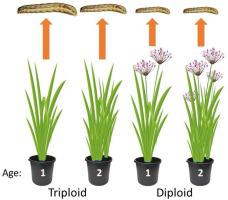Aquatic Botany ( IF 1.9 ) Pub Date : 2021-04-08 , DOI: 10.1016/j.aquabot.2021.103391 Nathan E. Harms , Damian Walter

|
Invasive plants may display age or genotype-specific defenses against herbivory. Thus, the importance of herbivory for preventing or mitigating plant invasions may depend on genetics and age-structure of invader populations. We used an excised-leaf experiment to test whether constitutive herbivore defenses in Butomus umbellatus L. (flowering rush) plants decline with age between colonizing (1st year) and established (2nd year) plants and whether the decline was parallel between introduced diploid and triploid genotypes. Leaves from colonizing and established plants were fed to the generalist herbivore fall armyworm (FAW; Spodoptera frugiperda) and then short-term FAW development was measured. Additionally, leaf dry matter content (DMC), % carbon (%C), % nitrogen (%N), carbon:nitrogen (C:N) ratio, and total leaf phenolics were determined for leaves from a subset of test plants. FAW fed leaves from diploid plants grew 27 % less than those fed leaves from triploid plants but were only 1 % smaller when fed leaves from second-year versus first-year plants of either cytotype. DMC of diploid leaves was 11 % greater overall (11 % DMC) but the difference in cytotypes depended on age (1 % difference in colonizing plants vs. 21 % difference in established plants). In general, diploid plants were characterized by 29 % higher total phenolics, 17 % less leaf nitrogen, and 21 % higher C:N ratio, regardless of age. Measured traits were, on average, 27 % more variable for diploid than triploid plants, possibly a reflection of increased genetic diversity of diploid flowering rush populations used in the study. These results demonstrate that diploid B. umbellatus plants are, overall, better defended against generalist herbivory than triploid plants. Differences in herbivore performance on B. umbellatus lineages, and to a lesser extent plants of varying ages, may therefore contribute to spatial or temporal heterogeneity in the dominance of genotypes in areas where they grow together.
中文翻译:

影响Butomus猪苓L.血统和年龄上的多面手毛虫叶化学性能
入侵植物可能会表现出抗草食性的年龄或基因型特异性防御能力。因此,食草对预防或减轻植物入侵的重要性可能取决于入侵者种群的遗传学和年龄结构。我们使用切叶试验来测试Butomus umbellatus L.(开花高峰)植物的组成性草食动物防御能力是否随定植(第1年)和成熟(第2年)植物之间的年龄下降,以及引入的二倍体和三倍体之间的下降是否平行基因型。将定植和定植的植物的叶子喂食全草食草秋天夜蛾(FAW;Spodoptera frugiperda),然后测量短期一汽发展。此外,测定了部分试验植物叶片的叶片干物质含量(DMC),%碳(%C),%氮(%N),碳:氮(C:N)和总酚含量。一倍体植物从二倍体植物中饲喂的叶片比三倍体植物中的叶片少生长27%,但是当两种细胞类型的二年级植物与一年级植物相比时,其叶片仅小1%。二倍体叶片的DMC总体上提高了11%(DMC为11%),但是细胞类型的差异取决于年龄(定植植物的差异为1%,成熟植物的差异为21%)。通常,与年龄无关,二倍体植物的特征是总酚含量高29%,叶氮含量低17%,C:N比高21%。二倍体的测量性状平均比三倍体植物多27%,可能反映了该研究中使用的二倍体开花高峰种群遗传多样性的增加。这些结果表明二倍体总体而言,与三倍体植物相比,伞形芽孢杆菌植物具有更好的抗普通草食性。因此,在伞形芽孢杆菌谱系和较小年龄的植物上,草食动物的性能差异可能会导致它们一起生长的区域中基因型优势的空间或时间异质性。











































 京公网安备 11010802027423号
京公网安备 11010802027423号